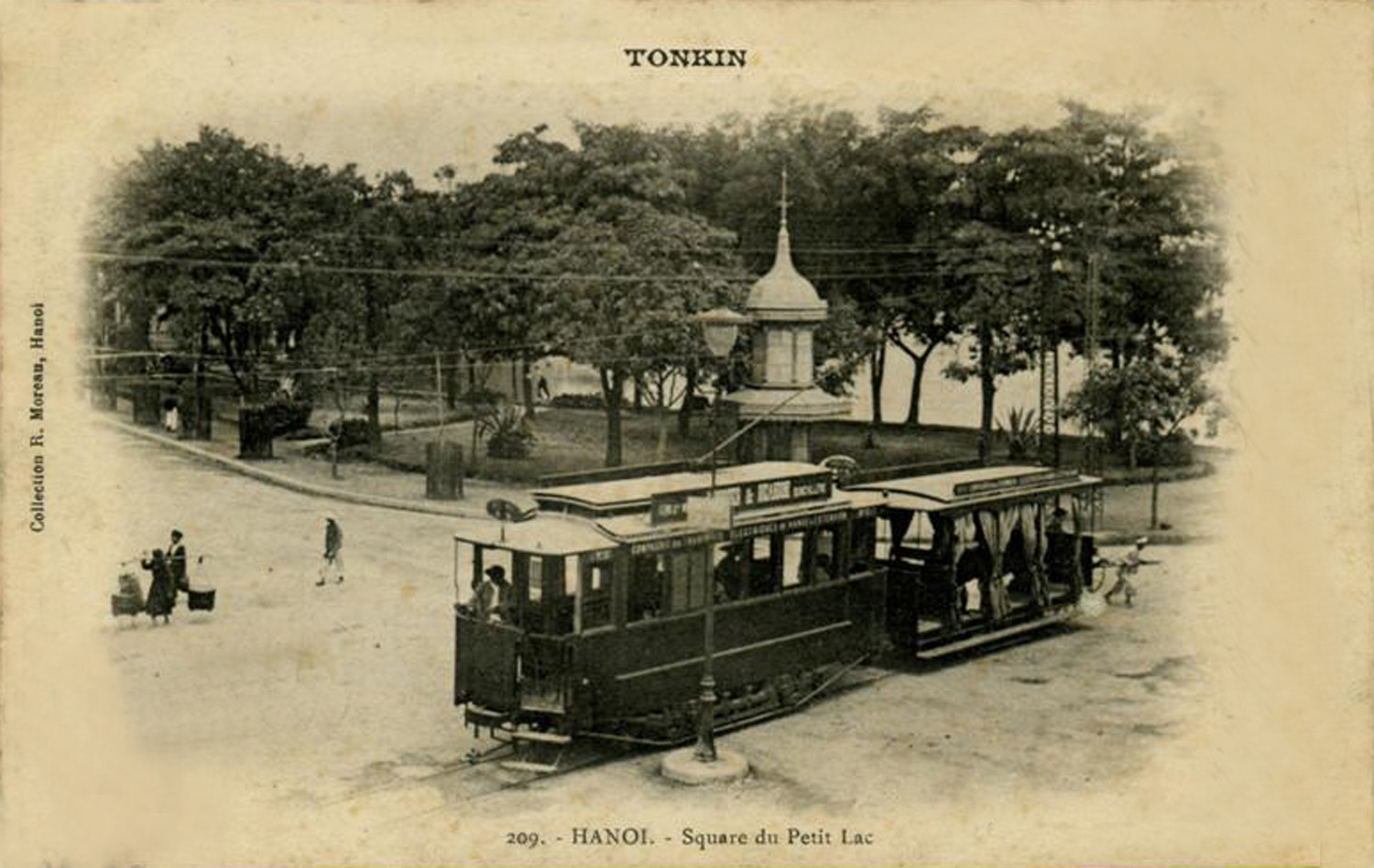
A CTEH Line 1 tram at the place des Cocotiers terminus
When they first drew up plans for a citywide tramway network in 1894, it seemed as though the Hà Nội authorities would follow Sài Gòn’s example by opting for steam traction. Yet by the time government approval was forthcoming in 1899, advances in technology made it possible to construct the entire system as a state-of-the-art 1m gauge electric tramway.
In 1900, the Compagnie des tramways électriques d’Hanoï et extensions (CTEH) was to set up to build the first two tramway lines, which were jointly inaugurated in November 1901.
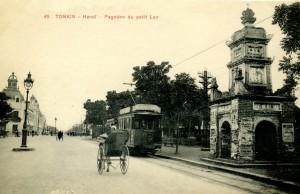
A CTEH Line 1 tram passes the “Petit Lac”
Setting out from the place des Cocotiers terminus next to the Petit lac (Hoàn Kiếm Lake), Line 1 led southward to Bạch Mai and Line 2 northeastward to Giấy village, near the today’s Bưởi Market. A subsequent decision of 20 July 1905 authorised the extension of Line 1 to Chợ Mơ.
In 1904, work began on Line 3, which led west from the Petit lac to the Pagode des Corbeaux (the Temple of Literature) and then headed southwest to Thái Hà Ấp. This line was extended to Hà Đông in 1914 and to Cầu Đơ market in 1938.
Construction of Line 4 got under way in 1907. Following the path of Line 3 from place des Cocotiers to the Pagode des Corbeaux, it then branched westward to the Pont du Papier (Cầu Giấy).
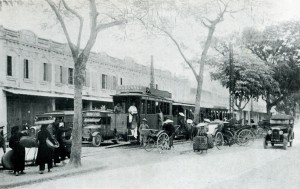
A CTEH Line 3 tram at Hà Đông
In its early years, despite its apparent popularity, the Hà Nội tramway network suffered continuous financial problems and until as late as 1913, CTEH remained a deficitary operation. Thereafter profits remained relatively modest, precluding adequate maintenance on its rolling stock, track, catenary and buildings. In 1927, the increasingly run-down network was taken over by a new group, which in 1929 constituted itself as the Compagnie des tramways du Tonkin (Tonkin Tramway Company, CTT). In that year, CTT embarked upon a major upgrade which involved the replacement of large stretches of track and catenary and the purchase of replacement second-generation tractor and trailer sets from France.
It was under the CTT that the final stage of network expansion was implemented. A decision of 14 November 1930 approved the creation of Line 5, which ran from Yên Phụ on the Red River Dyke in the north of the city to Kim Liên in the south of the city, the southernmost stretch of the line following the route Mandarine (now Lê Duẩn street). Line 5 briefly intersected Line 2 at Château d’eau (Bốt Nước Hàng Đậu) and Line 3 at place Neyret (now Cửa Nam). In 1943, Line 5 was extended further south as far as the route Circulaire, in order to serve the René Robin Hospital, the radio station and Bạch Mai airfield. With the completion of Line 5, the tramway network in Hà Nội had reached approximately 30km in length.
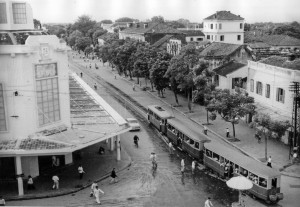
A Hà Nội Line 1 tram (1927 stock) heads south along Hàng Bài towards Bạch Mai in 1960
In 1952, at the height of the First Indochina War, the CTT was renamed the Société des transports en commun de la région de Hanoï. However, on 1 June 1955 this company ceased operations and all track, equipment and rolling stock was transferred to the new Democratic Republic of Việt Nam.
Unlike its Sài Gòn counterpart, the Hà Nội tramway system continued to function for nearly 30 years after independence, in fact in 1968 the Hà Nội People’s Committee even built an additional spur from the Cửa Nam junction along phố Cột Cờ (now đường Điện Biên Phủ) and đường Hùng Vương, rejoining Line 2 south of Trúc Bạch Lake. However by the early 1980s, track, catenary and rolling stock had deteriorated to the extent that the tramway was no longer fit for purpose. Line 1 (Bạch Mai Phong) was closed in 1982, followed in subsequent years by Line 4 (Cầu Giấy), Line 3 (Hà Đông), Line 5 (Yên Phụ) and finally in 1989 Line 2 (đường Bưởi).
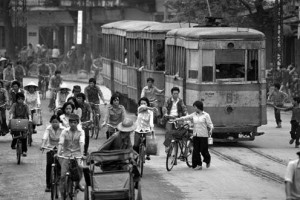
A Hà Nội Line 2 tram (1927 stock) picture in the 1980s
Line 4 (Cầu Giấy) was offered a brief reprieve of sorts in 1986, when the route was taken over by a small donated fleet of old trolley buses from Eastern Europe. The Hà Nội-Cầu Giấy trolley bus fleet outlasted the trams, soldiering on until 1993, when it too fell victim to modernisation.
Tim Doling is the author of The Railways and Tramways of Việt Nam (White Lotus Press, Bangkok, 2012) and also gives talks on Việt Nam railway history to visiting groups.
A full index of all Tim’s blog articles since November 2013 is now available here.
Join the Facebook group Rail Thing – Railways and Tramways of Việt Nam for more information about Việt Nam’s railway and tramway history and all the latest news from Vietnam Railways.
You may also be interested in these articles on the railways and tramways of Việt Nam, Cambodia and Laos:
A Relic of the Steam Railway Age in Da Nang
By Tram to Hoi An
Date with the Wrecking Ball – Vietnam Railways Building
Derailing Saigon’s 1966 Monorail Dream
Dong Nai Forestry Tramway
Full Steam Ahead on Cambodia’s Toll Royal Railway
Goodbye to Steam at Thai Nguyen Steel Works
How Vietnam’s Railways Looked in 1927
Indochina Railways in 1928
“It Seems that One Network is being Stripped to Re-equip Another” – The Controversial CFI Locomotive Exchange of 1935-1936
Phu Ninh Giang-Cam Giang Tramway
Saigon Tramway Network
Saigon’s Rubber Line
The Changing Faces of Sai Gon Railway Station, 1885-1983
The Langbian Cog Railway
The Long Bien Bridge – “A Misshapen but Essential Component of Ha Noi’s Heritage”
The Lost Railway Works of Truong Thi
The Mysterious Khon Island Portage Railway
The Railway which Became an Aerial Tramway
The Saigon-My Tho Railway Line

